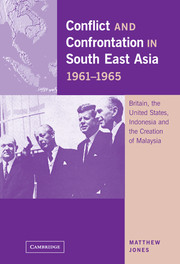 Conflict and Confrontation in South East Asia, 1961–1965
Conflict and Confrontation in South East Asia, 1961–1965 Book contents
- Frontmatter
- Contents
- List of maps
- Preface and acknowledgements
- List of abbreviations
- South East Asia
- Indonesia and Malaysia
- Introduction: Britain, the United States and the South East Asian setting
- Part I Build-up
- 1 The Kennedy Administration, Indonesia and the resolution of the West Irian crisis, 1961–1962
- 2 The Greater Malaysia scheme I: the move towards merger
- 3 The Greater Malaysia scheme II: the Cobbold Commission and the Borneo territories
- 4 Britain, Indonesia and Malaya: from West Irian to the Brunei revolt
- Part II Outbreak
- Part III Denouement
- Conclusion: The Western presence in South East Asia by the 1960s
- Bibliography
- Index
3 - The Greater Malaysia scheme II: the Cobbold Commission and the Borneo territories
Published online by Cambridge University Press: 25 July 2009
- Frontmatter
- Contents
- List of maps
- Preface and acknowledgements
- List of abbreviations
- South East Asia
- Indonesia and Malaysia
- Introduction: Britain, the United States and the South East Asian setting
- Part I Build-up
- 1 The Kennedy Administration, Indonesia and the resolution of the West Irian crisis, 1961–1962
- 2 The Greater Malaysia scheme I: the move towards merger
- 3 The Greater Malaysia scheme II: the Cobbold Commission and the Borneo territories
- 4 Britain, Indonesia and Malaya: from West Irian to the Brunei revolt
- Part II Outbreak
- Part III Denouement
- Conclusion: The Western presence in South East Asia by the 1960s
- Bibliography
- Index
Summary
By the early 1960s the days of formal European empires appeared to be numbered. As nationalist movements began to move into power in Asia and Africa, and as independence was granted by, or wrested from, the departing Europeans, the principle of self-determination became firmly established once more in the value-system of international affairs. The dominant anti-colonial mood was most prominently reflected in the changing make-up and atmosphere of the United Nations. In 1960 the General Assembly had passed a resolution (without dissent) that, ‘All peoples have the right of self-determination … Inadequacy of political, economic, social or educational preparedness should never serve as a pretext for delaying independence.’ The British could be sure that their handling of the Malaysia issue would be subject to a degree of international scrutiny, and they were determined that the veneer of legitimacy should be attached to the whole process. Among some officials, it must also be recognized, there was a genuine sense of responsibility and a desire to chart the best course for peoples about to be released into a potentially hostile local environment. There was, in addition, a practical need to ensure the widest degree of support for the idea of joining Malaysia from the populations of Sarawak and North Borneo. As ministers were only too aware, there was the unhappy precedent of the Central African Federation to consider, established against the wishes of the African majority in the early 1950s, and which by 1961 was in the final stages of collapse.
- Type
- Chapter
- Information
- Conflict and Confrontation in South East Asia, 1961–1965Britain, the United States, Indonesia and the Creation of Malaysia, pp. 79 - 97Publisher: Cambridge University PressPrint publication year: 2001


